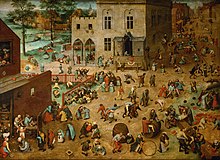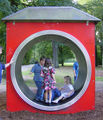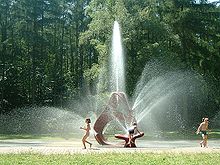playground
A playground or children's playground is a place with several different play equipment that children (mostly up to 14 years of age) can play with or on . Playgrounds are often located in settlements or densely populated areas. Sometimes they are separated from an adjacent street by a fence. A football field (space for ball games) is rarely part of the playground area. The integration in green areas and the allocation of lawns are considered favorable .
The building regulations of most of the German federal states explicitly stipulate the construction of children's playgrounds. For example, the Bavarian building regulations require that a sufficiently large playground is to be created when constructing buildings with more than three apartments, unless there is already a playground nearby (cf. Art. 8 Para. 1 BayBO). There is hardly a large residential project that can be built without an associated children's playground. Public and municipal playgrounds must be checked for suitability and safety at least once a year. Housing associations are also required to regularly replace the sand in the boxes. Dogs are strictly forbidden on most playgrounds .
The social behaviors that children develop in the playground become skills that will remain effective into adulthood. Studies found that playgrounds are one of the most important places for children to develop outside of the home. Most forms of play are essential for healthy development; free, spontaneous play, such as occurs in playgrounds, is considered to be a beneficial type of play.
history

Probably the oldest representation of a public square in which children play is the painting The Children's Games by the Flemish painter Pieter Bruegel the Elder . In the early 19th century, the German doctor and architectural theorist Bernhard Christoph Faust called for children's playgrounds to be set up within the framework of solar engineering. This was subsequently implemented more and more. During the Covid-19 pandemic in 2020, many playgrounds in Germany were closed for weeks.
Legal basis
Public playgrounds are the municipalities' freely accessible playgrounds. In Germany, all playgrounds in residential buildings (with the exception of single-family houses), schools, kindergartens, restaurants, shopping centers, facilities used for tourism, associations and the like are public.
In the European Union, public playgrounds and the playground equipment there have had to comply with the European standard EN 1176 and 1177 since 1998. Before that, the German standard DIN 7926 was in force in Germany. DIN 18034 (playgrounds and open spaces for playing - requirements for planning, construction and operation) and for playgrounds in schools and kindergartens the regulations of the DGUV (German statutory accident insurance) must also be observed ). The playground operator is responsible not only for the construction and proper installation and arrangement of the playground equipment, but also for ongoing maintenance and repair.
In the EU, the weaker EN 71 applies to private playgrounds and play equipment (only those used by the company itself). The equipment built according to this standard is cheaper, but also more unstable, less durable and less durable, and for this reason not for economic reasons for playgrounds in kindergartens, shared apartment buildings, etc. s. w. suitable.
These standards (especially the EN 1176 and EN 1177 standards) are a benchmark for the basic precautions to be taken into account when building and operating a playground. The standards determine the content and scope of the road safety obligations , as they give an indication of the state of the recognized rules of technology applicable to the circles concerned. This means that in Germany you are ultimately liable for damages according to § 823 BGB if you have violated one of these standards. In addition, someone who complies with the standards can also be punished there, e.g. B. due to a judgment of the Higher Regional Court of Celle from May 28, 2003 - 9U 7/03:
"However, the manufacturer of a playground device must regularly comply with the recognized rules of technology with regard to its design requirements: He may be content with this, provided that these rules do not lag behind technical or scientific developments and recent knowledge of dangers."
Therefore, new accident events must also be taken into account, without these being included in changes to the standard. For example, EN 1176 specifies: Up to a fall height of 0.60 meters, there are no requirements for the fall protection material, the extent of the fall space is 1.50 meters around the device. However, this must be kept free of obstacles and objects. For fall heights of 0.60 meters to 1.50 meters, the fall space must be 1.50 meters wide and the ground in the fall space must consist of lawn. From a fall height of 1.50 meters, suitable sand, gravel, wood chips or bark mulch in a sufficient layer thickness (at least 20 cm) or synthetic fall protection is required.
A visual inspection should be carried out up to daily in heavily frequented playgrounds, an operational inspection every one to three months (check for function and stability) and the annual main inspection should be carried out annually by a specialist. In Germany this should be a qualified playground inspector according to DIN 79161 .
Playground design
Age assignments
The playgrounds, sports and leisure areas as well as their play facilities and equipment are divided into the following age groups in the planning phase:
- Toddler area for 0–6 year olds: usable play area of at least 150 square meters, at least equipped with a sandpit, slides and a swing.
- General playgrounds for 6–12 year olds: usable play area of at least 2,000 square meters, equipped with different climbing combinations, turntables, ball playgrounds, sand areas, hills, areas for free, natural play, play areas, football fields.
- Playgrounds for 12-18 year olds: climbing walls, ball game areas including table tennis tables, skate facilities, separate seating areas for chatting , areas for free and natural play; measure other areas for sport and strength; Youth meeting places.
- Educationally supervised playgrounds with 4000 square meters of usable area and temporary leisure facilities such as ice rinks or toboggan runs complete the municipal playground offer.
Rest areas and offers for older citizens, which are equipped with, for example, seating, lawn and sunbathing areas, fitness equipment for training strength, balance, mobility, are not assigned directly to the playgrounds; Family game; Exercise or vita course; Ball games including table tennis and boules alleys; barrier-free path connections; Areas for running and walking; Board games; Lawns for gymnastic exercises and meditation.
Structural and organizational matters
- Using post shoes on wooden posts prevent the wood from weathering through direct contact with the ground.
- Track construction planks ( railway sleepers ) usually contain dangerous wood preservatives . The labeling of the thresholds can be used to determine whether the means used are harmless.
- Use of sand, rubber granulate or gravel as fall protection and no wood chips or bark mulch . These tend to form mold or contain fungicides.
- No use of play equipment according to EN 71 (e.g. from hardware stores) for public playgrounds. These devices are only intended for private use and are less durable than devices according to EN 1176.
- Slides facing south can heat up due to solar radiation.
In the European Union, the planning of the playground equipment and the monitoring of production and construction must be carried out by an expert on the basis of EN 1176/1177. No qualifications are required to build the playground equipment itself. In Germany, an inspection by the TÜV or similar institutions does not have to be carried out. Coordination with the responsible insurance company (in Germany mostly the Landesunfallkasse [LUK] or the municipality accident insurance [GUV]) is recommended, as the insurance will also assume liability after approval. The acceptance is carried out by the planner or another expert (e.g. in Germany by a qualified playground inspector according to DIN 79161) and recorded in a report, which, like all other test reports, should be collected in a play equipment file.
In Berlin, the maintenance of leisure facilities is carried out on the basis of the Senate's implementation regulation for traffic safety and public playgrounds .
Playground equipment (selection)
Play equipment includes: Play towers , climbing walls , climbing equipment , miniature wooden houses , slides , swings , seesaws , sandboxes , carousels , cable cars , water play equipment (e.g. mud facilities), balancing and gymnastics equipment, etc.
Labelling
The age classification should be indicated on the playground or the equipment. Some Berlin district administrations do not see such a label as necessary and state: “... on the one hand, the competence of the supervisors would be called into question, on the other hand, the biological age of a child says nothing about its coordination skills and strength. The size of some equipment alone gives an indication of the target group. In addition, the design regulations provide for a triple safety factor, which means that the use of all devices by older children and even adults is unproblematic. And football fields receive an additional sign "for children under 18 years" with a reference to the rest periods to be observed. "
If the playground is marked on a sign with a memorable and unambiguous name, the whereabouts can simply be announced in the event of an emergency.
Often do's and don'ts are shown on signs as pictograms : biking, prohibition of addictive substances, prohibition of dogs, no use in snow and ice as well as removal of helmets.
Since the telephone numbers of the responsible office or playground operator change from time to time, these can advantageously be attached as stickers. The associated telephone numbers should be given as a permanent installation. In Germany this would be the authority number 115 and the number of the medical emergency number.
Accidents in playgrounds
Accidents can often be traced back to defects in the devices that could have been avoided with expert checks. In the case of fatal and serious accidents, three categories of defects predominate:
- Unstable posts, foundations, anchors in the ground, mainly caused by wood rot as a result of fungal attack. Wooden single-mast devices are particularly at risk. Injuries result from a fall or from falling parts of the device.
- Traps for clothing, e.g. B. Gaps between 3.6 mm and 25 mm, angles less than 60 degrees or the ends of rods and other components on which chains, hoods, anorak cords, scarves, key rings, bicycle helmet straps get caught.
- Catch points for the head due to distances between 8.9 cm and 23 cm (according to EN 1176: 2008) between boards and the like. Children can slide in and strangle themselves with their own weight.
Catch points with openings larger than 23 cm are also problematic with bicycle helmets. Therefore helmets should not be worn on playgrounds and a warning sign with a crossed out bicycle helmet should be put up.
Special forms of playgrounds
Experience scope
There are opportunities to develop playgrounds into adventure spaces. This includes an appealing terrain modeling, the inclusion of the vegetation, especially the trees, the possibility to play and muddy with water . Quiet areas are designed to encourage communication and creative play. Additions with sensory elements such as forest xylophone, buzzing and sounding stones, barefoot path expand the range of experiences. Ideally, a space for experience contains offers for all generations, such as B. garden chess , beach volleyball , bowling green .
Adventure playground
Adventure playgrounds are usually looked after by teachers or social pedagogues and offer the children opportunities to use tools (e.g. when building a hut). Since adventure playgrounds are not freely accessible and supervised, they are not subject to playground standards and do not have to be inspected and inspected. The supervisors are responsible for safety.
Multi-generation place
A playground can also be redesigned to be used by “young and old”. For example, an adjacent area for older people can be equipped with special play and training equipment. A slightly different solution are special senior playgrounds (also known as “senior activity parcours” or similar), which can be attached to a senior center or clinic or set up as an exercise park in public parks. The term “senior playground” names the concept of a delimited exercise area ( exercise area ) outdoors. Such facilities also often have play areas, e.g. B. for bocce .
See also
literature
- Carles Broto: Playground Design . Links Books, Barcelona 2009. ISBN 978-84-92796-32-8
- German Institute for Standardization (Ed.): Playgrounds and leisure facilities = DIN pocket book 105. 7th edition. Beuth, Berlin 2012. ISBN 978-3-410-22854-7
- Peter Fibich: On climbing mushrooms and sliding elephants - public playgrounds in the GDR . In: Die Gartenkunst 28 (1/2016), pp. 119–126.
- Brigitte Kleinod: Play areas. Plan - design - calculate . = The garden planner 5. Ulmer, Stuttgart 2001, ISBN 978-3-8001-3590-5
- Daniel Rimbach: To establish public outdoor facilities for children until the end of the Weimar Republic . In: Die Gartenkunst 28 (1/2016), pp. 103–112.
Web links
- Architecture for children - pioneers and important playground architects and their publications
- Bundesarbeitsgemeinschaft Mehr Sicherheit für Kinder e. V.
- Leaflet for playground operators, published by the Federal Working Group "More Safety for Children eV"
- Federal Association for Playground Equipment and Leisure Facilities Manufacturers V.
- Germany-wide playground catalog
- GUV information on outdoor play areas and playground equipment , PDF (1.32 MB)
- Guidelines for kindergartens - construction and equipment , PDF (126 kB)
Individual evidence
- ↑ Text of the building regulations from 1998 (PDF)
- ^ Bernhard Christoph Faust: Sudhoffs archive for the history of medicine and the natural sciences . tape 24 . F. Steiner, 1931, p. 309 ( online in Google Book Search).
-
↑ Wojciech Băluş: children and youth in the People's Garden. From the beginning to the creation of the Reform Park . In: Die Gartenkunst 13 (1/2001), pp. 65–76;
* Daniel Rimbach: To establish public outdoor facilities for children until the end of the Weimar Republic . In: Die Gartenkunst 28 (1/2016), pp. 103–112;
* Peter Fibich: About climbing mushrooms and sliding elephants. Public playgrounds in the GDR . In: Die Gartenkunst 28 (1/2016), pp. 119–126. - ↑ Playground equipment and playground floors - Part 1: General safety requirements and test methods; German version EN 1176-1: 2008
- ↑ DIN standards committee for sports and leisure equipment (NASport)
- ↑ Note: DIN 79161 is intended to enable clients to compare the performance of the experts. DIN 79161 regulates the requirements for the seminar leader, the seminar content and the seminar period. Furthermore, the examination questions are prepared by the FLL for all seminar providers. This ensures an equivalent test.
- ↑ GUV-SI 8073: Planning, designing and using schoolyards . GUV-SI 8017: outdoor play areas and playground equipment .
- ↑ a b Berlin Children's Playground Act in the 2003 version
- ↑ Katrin Bartel: Build play equipment yourself , expert office for wood protection
- ↑ Implementation regulation traffic safety for public playgrounds in Berlin (status 2010).
- ↑ On the age rating: From a conversation with the Lichtenberg District City Council on the subject of playgrounds, in October 2012.


















